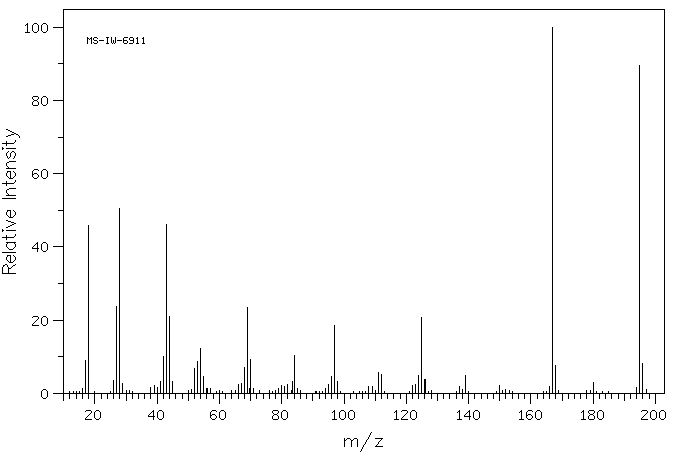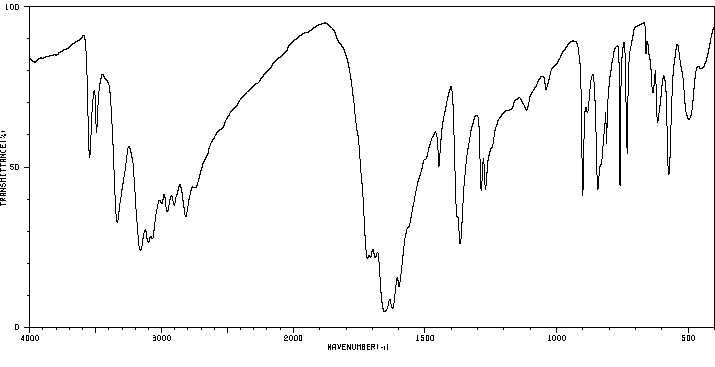无色喋呤 | 492-11-5
中文名称
无色喋呤
中文别名
白喋呤
英文名称
2-Amino-4,6,7-trihydroxypteridin
英文别名
Leukopterin;2-amino-5,8-dihydro-3H-pteridine-4,6,7-trione;2-aminopteridine-4,6,7-triol;leucopterin;Leucopterin;2-amino-5,8-dihydro-3H-pteridine-4,6,7-trione
CAS
492-11-5
化学式
C6H5N5O3
mdl
MFCD00047572
分子量
195.137
InChiKey
SFLOGVVDXPCWGR-UHFFFAOYSA-N
BEILSTEIN
——
EINECS
——
-
物化性质
-
计算性质
-
ADMET
-
安全信息
-
SDS
-
制备方法与用途
-
上下游信息
-
文献信息
-
表征谱图
-
同类化合物
-
相关功能分类
-
相关结构分类
物化性质
-
熔点:300 °C
-
沸点:331.78°C (rough estimate)
-
密度:1.5875 (rough estimate)
-
溶解度:可溶于水基(轻微)
计算性质
-
辛醇/水分配系数(LogP):-2.4
-
重原子数:14
-
可旋转键数:0
-
环数:2.0
-
sp3杂化的碳原子比例:0.0
-
拓扑面积:126
-
氢给体数:4
-
氢受体数:4
SDS
制备方法与用途
制备方法
适用于生化研究和有机合成。
用途简介暂无具体内容。
上下游信息
反应信息
-
作为反应物:描述:参考文献:名称:Albert; Wood, Journal of Applied Chemistry, 1952, vol. 2, p. 591摘要:DOI:
-
作为产物:描述:参考文献:名称:ÜberPterinchemie 75. Mitteilung von 7-Aminoxanthopteropterin † ‡的合成摘要:7-氨基黄嘌呤蝶呤的合成DOI:10.1002/hlca.19800630708
文献信息
-
Regulation of Xanthine Oxidase Activity by Substrates at Active Sites via Cooperative Interactions between Catalytic Subunits: Implication to Drug Pharmacokinetics作者:L. A. Tai、K. C. HwangDOI:10.2174/092986711793979760日期:2011.1.1Three xanthine oxidase substrates (i.e., xanthine, adenine, and 2-amino-4-hydroxypterin) show a “substrate inhibition” pattern (i.e., slower turnover rates at higher substrate concentrations), whereas another two substrates (i.e., xanthopterin and lumazine) show a “substrate activation” pattern (i.e., higher turnover rates at higher substrate concentrations). Binding of a 6-formylpterin at one of the two xanthine oxidase active sites slows down the turnover rate of xanthine at the adjacent active site from 17.0 s-1 to 10.5 s-1, and converts the V-[S] plot from “substrate inhibition” pattern to a classical Michaelis-Menten hyperbolic saturation pattern. In contrast, binding of xanthine at an active site accelerates the turnover rate of 6-formylpterin at the neighboring active site. The experimental results demonstrate that a substrate can regulate the activity of xanthine oxidase via binding at the active sites; or a xanthine oxidase catalytic subunit can simultaneously serve as a regulatory unit. Theoretical simulation based on the velocity equation derived from the extended Michaelis-Menten model shows that the substrate inhibition and the substrate activation behavior in the V-[S] plots could be obtained by introducing cooperative interactions between two catalytic subunits in homodimeric enzymes. The current work confirms that there exist very strong cooperative interactions between the two catalytic subunits of xanthine oxidase.三种黄嘌呤氧化酶底物(即黄嘌呤、腺嘌呤和2-氨基-4-羟基吡啶)表现出“底物抑制”模式(即在较高底物浓度下,转化速率较慢),而另两种底物(即黄吡啶和光亮素)则表现出“底物激活”模式(即在较高底物浓度下,转化速率较高)。在两个黄嘌呤氧化酶活性位点中的一个结合6-形式吡啶会使邻近活性位点的黄嘌呤转化速率从17.0 s-1减慢至10.5 s-1,并将V-[S]图从“底物抑制”模式转换为经典的米氏-孟德尔曲线饱和模式。相反,在活性位点结合黄嘌呤会加速邻近活性位点6-形式吡啶的转化速率。实验结果表明,底物可以通过在活性位点的结合调节黄嘌呤氧化酶的活性;同时,黄嘌呤氧化酶的催化亚单位也可以作为调节单位。基于从扩展米氏-孟德尔模型推导出的速率方程的理论模拟表明,V-[S]图中的底物抑制和底物激活行为可以通过引入同源二聚体酶中两个催化亚单位之间的协同作用来获得。目前的研究确认了黄嘌呤氧化酶的两个催化亚单位之间存在非常强的协同作用。
-
Oxydation des Xanthopterins in Leukopterin durch Perjodsäure
-
Stripping agent composition and method of stripping申请人:——公开号:US20040029051A1公开(公告)日:2004-02-12A stripping composition comprising (a) an anticorrosive agent, (b) a stripping agent and (c) a solvent, wherein the anticorrosive agent (a) is a heterocyclic compound having a nitrogen atom-containing six-membered ring.
-
Non-toxic corrosion-protection pigments based on manganese申请人:——公开号:US20040011252A1公开(公告)日:2004-01-22Corrosion-inhibiting pigments based on manganese are described that contain a trivalent or tetravalent manganese/valence stabilizer complex. An inorganic or organic material is used to stabilize the trivalent or tetravalent manganese ion to form a compound that is sparingly soluble, exhibits low solubility, or is insoluble in water, depending upon the intended usage. Specific stabilizers are chosen to control the release rate of trivalent or tetravalent manganese during exposure to water and to tailor the compatibility of the powder when used as a pigment in a chosen binder system. Stabilizers may also modify the processing and handling characteristics of the formed powders. Manganese/valence stabilizer combinations are chosen based on the well-founded principles of manganese coordination chemistry. Many manganese-valence stabilizer combinations are presented that can equal the performance of conventional hexavalent chromium or tetravalent lead systems. It is emphasized that this abstract is provided to comply with the rules requiring an abstract which will allow a searcher or other reader to quickly ascertain the subject matter of the technical disclosure. It is submitted with the understanding that it will not be used to interpret or limit the scope or meaning of the claims.以锰为基础的缓蚀颜料含有三价或四价锰/价稳定剂复合物。一种无机或有机材料可用于稳定三价或四价锰离子,从而形成一种可少量溶解、溶解度低或不溶于水的化合物,具体取决于预期用途。选择特定的稳定剂是为了控制三价锰或四价锰在遇水时的释放率,并调整粉末在所选粘合剂体系中用作颜料时的相容性。稳定剂还可以改变成型粉末的加工和处理特性。锰/价稳定剂组合的选择是基于锰配位化学的基本原理。文中介绍了许多锰价稳定剂组合,其性能与传统的六价铬或四价铅体系相当。需要强调的是,提供本摘要是为了符合要求提供摘要的规则,以便检索者或其他读者快速确定技术公开的主题。提交本摘要的前提是,本摘要不用于解释或限制权利要求的范围或含义。
-
Non-toxic corrosion-protection pigments based on rare earth elements申请人:——公开号:US20040104377A1公开(公告)日:2004-06-03A corrosion-inhibiting pigment comprising a rare earth element and a valence stabilizer combinded to form a rare earth/valence stabilizer complex. The rare earth element is selected from cerium, terbium, praseodymium, or a combination thereof, and at least one rare earth element is in the tetravalent oxidation state. An inorganic or organic material is used to stabilize the tetravalent rare earth ion to form a compound that is sparingly soluble in water. Specific stabilizers are chosen to control the release rate of tetravalent cerium, terbium, or praseodymium during exposure to water and to tailor the compatibility of the powder when used as a pigment in a chosen binder system. Stabilizers may also modify the processing and handling characteristics of the formed powders. Many rare earth-valence stabilizer combinations are presented that can equal the performance of conventional hexavalent chromium systems.
表征谱图
-
氢谱1HNMR
-
质谱MS
-
碳谱13CNMR
-
红外IR
-
拉曼Raman
-
峰位数据
-
峰位匹配
-
表征信息
同类化合物
黄素酰色氨酸
高蝶酸
骏河毒素
酵母粉
诺米林酸17-β-D-吡喃葡萄糖苷
蝶酸
蝶啶3-氧化物
蝶啶-6-基-甲醇
蝶啶-4,6-二胺
蝶啶-2,4-二胺
蝶呤-6-羧酸
苯癸酸,2-羟基-3,4-二甲氧基-6-甲基
苯并[g]蝶啶-4a(2H)-基,5-乙基-3,4,5,10-四氢-3,7,8,10-四甲基-2,4-二羰基-
苯并[g]蝶啶-2,4(1H,3H)-二酮,5-乙酰基-5,10-二氢-1,3-二甲基-
苯并[g]蝶啶-2,4(1H,3H)-二酮,5,10-二氢-7,8-二甲基-
苯并[g]蝶啶-2,4(1H,3H)-二酮,1,7,8-三甲基-
羧甲基黄素
羟基-2-吡啶酮
维生素 B2
维他命 B2
硫酸氢3-(6,7-二氯-2,4-二羰基-3,4-二氢苯并[g]蝶啶-10(2H)-基)-N-乙基-N-(2-羟基乙基)丙烷-1-铵
硫酸氢2-(7,8-二氯-2,4-二羰基-3,4-二氢苯并[g]蝶啶-10(2H)-基)-N,N-二甲基乙铵
甲氨蝶呤钠
甲氨蝶呤杂质1
生物蝶呤-d3
生物喋呤中间体
环己烯,3-氟-4-(甲硫基)-,反-(9CI)
玫瑰黄色素
溴化氢溴化1-(2-氨基乙基)-3-甲基-4-[(Z)-2-萘-1-基乙烯基]吡啶正离子
氯化3-(7-氯-2,4-二羰基-3,4-二氢苯并[g]蝶啶-10(2H)-基)-N,N-二甲基丙烷-1-铵
氨蝶呤钠
氨苯蝶啶
氨甲酸,[(1S)-2-羟基-1-甲基丙基]-,1,1-二甲基乙基酯(9CI)
氨甲蝶呤
氨基蝶呤
核黄素还原
核黄素杂质Q
核黄素5'-硫酸盐
核黄素3′,4′-二磷酸酯
核黄素-4'-磷酸
核黄素-3'-磷酸盐
核黄素,2',3',4',5'-四乙酸酯
核黄素 5'-丁酸酯
核黄素
无色喋呤
异黄蝶呤
己二酸,2-[[4-[[(2-氨基-1,4,5,6,7,8-六氢-4-羰基-6-蝶啶基)甲基]氨基]苯甲酰]氨基]-
左亚叶酸钙杂质
左亚叶酸钙
四氢蝶酰五谷氨酸酯








